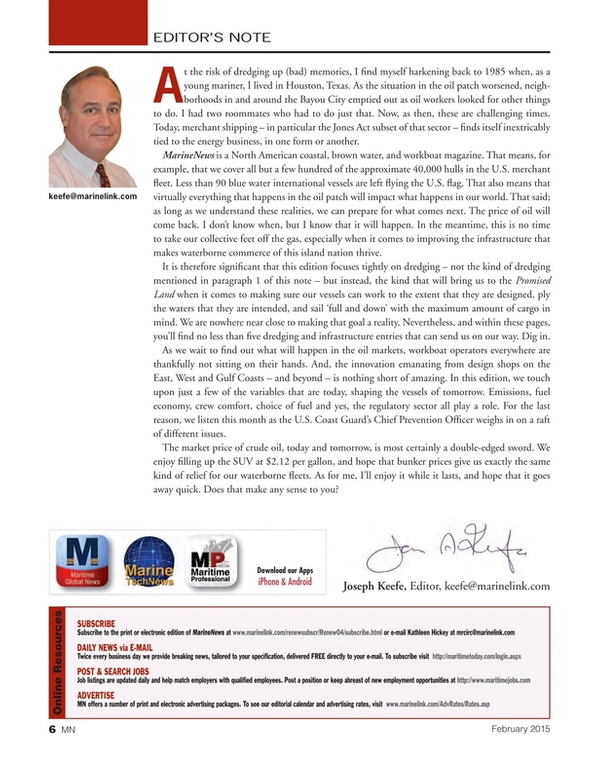
Editor's Note: Energy Market's Double-edged Sword
At the risk of dredging up (bad) memories, I find myself harkening back to 1985 when, as a young mariner, I lived in Houston, Texas. As the situation in the oil patch worsened, neighborhoods in and around the Bayou City emptied out as oil workers looked for other things to do. I had two roommates who had to do just that. Now, as then, these are challenging times. Today, merchant shipping – in particular the Jones Act subset of that sector – finds itself inextricably tied to the energy business, in one form or another.
MarineNews is a North American coastal, brown water, and workboat magazine. That means, for example, that we cover all but a few hundred of the approximate 40,000 hulls in the U.S. merchant fleet. Less than 90 blue water international vessels are left flying the U.S. flag. That also means that virtually everything that happens in the oil patch will impact what happens in our world. That said; as long as we understand these realities, we can prepare for what comes next. The price of oil will come back. I don’t know when, but I know that it will happen. In the meantime, this is no time to take our collective feet off the gas, especially when it comes to improving the infrastructure that makes waterborne commerce of this island nation thrive.
It is therefore significant that this edition focuses tightly on dredging – not the kind of dredging mentioned in paragraph 1 of this note – but instead, the kind that will bring us to the Promised Land when it comes to making sure our vessels can work to the extent that they are designed, ply the waters that they are intended, and sail ‘full and down’ with the maximum amount of cargo in mind. We are nowhere near close to making that goal a reality. Nevertheless, and within these pages, you’ll find no less than five dredging and infrastructure entries that can send us on our way. Dig in.
As we wait to find out what will happen in the oil markets, workboat operators everywhere are thankfully not sitting on their hands. And, the innovation emanating from design shops on the East, West and Gulf Coasts – and beyond – is nothing short of amazing. In this edition, we touch upon just a few of the variables that are today, shaping the vessels of tomorrow. Emissions, fuel economy, crew comfort, choice of fuel and yes, the regulatory sector all play a role. For the last reason, we listen this month as the U.S. Coast Guard’s Chief Prevention Officer weighs in on a raft of different issues.
The market price of crude oil, today and tomorrow, is most certainly a double-edged sword. We enjoy filling up the SUV at $2.12 per gallon, and hope that bunker prices give us exactly the same kind of relief for our waterborne fleets. As for me, I’ll enjoy it while it lasts, and hope that it goes away quick. Does that make any sense to you?
(As published in the February 2015 edition of Marine News - http://magazines.marinelink.com/Magazines/MaritimeNews)
Read Editor's Note: Energy Market's Double-edged Sword in Pdf, Flash or Html5 edition of February 2015 Marine News
Other stories from February 2015 issue
Content
- Editor's Note: Energy Market's Double-edged Sword page: 6
- Insights: Rear Admiral Paul F. Thomas page: 12
- The Quest to Fund Inland Waterways page: 18
- Moving Ahead With the Harbor Maintenance Trust Fund page: 21
- Avoiding Pitfalls on the Water page: 22
- A Gift to US Inland Waterways page: 26
- Propellers: One Size and Shape Does Not Fit All page: 28
- Powering Ahead with a Clean Design page: 32
- WWII Museum’s PT Boat Readies for Passengers page: 36
- In Safety, Quality Comes First page: 42
- Balanced Dredging with E-Crane page: 45
- Futuristic Bridge Concept by Rolls-Royce page: 47


